Soldier Story: Masaaki Roy Okuda
Soldier Story
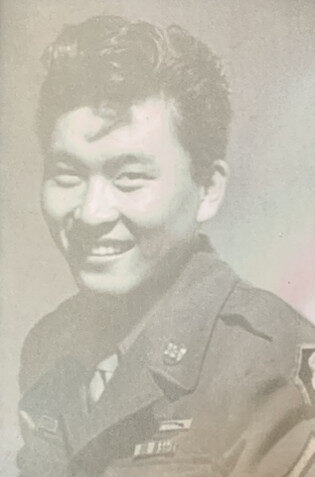
Masaaki Okuda was born on May 18, 1923, in Reedley, California, near Fresno. He was the son of Teiju and Setsuno (Yamada) Okuda. There were eight children in the family: Kaoru Kay, Sadanobu Sam, Masaaki Roy, Robert Sadamatsu, Isao Frank, Gilbert Shoji, Minoru, and Chigusa Geraldine.
Teiju arrived in San Francisco, California, in 1902 from Osaka Urban Prefecture, Japan. In 1910, he was one of 17 hired men living on a farm in Sacramento County. Setsuno Okuda arrived in San Francisco on the Tenyo Maru on December 27, 1915. She was from the village of Shinke, Osaka Urban Prefecture. She was enroute to her husband Teiju (14 years her senior) in San Francisco. On the immigration manifest, she was listed as a housewife; however, this was crossed out and “domestic” written in – indicating she and Teiju may have married after her arrival.
In 1920, Teiju and Setsuno were living in Fresno with their 2-year-old daughter Kaoru. Teiju was a farm laborer and there were four farm laborers lodging with them.
In 1930, the family was living on Rose Avenue in Fresno where Teiju was a farmer. There were five farm laborers boarding with the family. By 1940, they had moved to Sumner Avenue and father Teiju was retired.
After Executive Order 9066 was announced on February 19, 1942, Setsuno and the children were evacuated to the Merced WCCA Assembly Center located at the Merced County Fairgrounds. Teiju was sent to the Stockton WCCA Assembly Center.
Roy or Mas, as Masaaki was also known, registered for the draft on June 30, 1942, Local Board No. 115, in the Merced County Library Building. He lived with his family in Unit A-1-11 at the Merced WCCA Assembly Center and he was a student. His point of contact was brother Sadanobu. The family’s home was on Route 3 near Delhi, Merced County. Roy was 5’10-½” tall and weighed 149 pounds.
On October 19, 1942, father Teiju was incarcerated at the Rohwer WRA Camp in Arkansas. He was released on September 23, 1943, for employment in Chicago, Illinois.
One month earlier, on September 16, 1942, Setsuno and the children were incarcerated at Amache WRA Camp (also known as Granada), located in southeast Colorado. They lived in Unit 9E-7C. Robert Sadamatsu was released to Boulder, Colorado, for employment on July 1, 1943. On November 17, 1943, Roy was released by invitation to Des Moines, Iowa. Sam was released on January 6, 1944, to Fort Logan, Colorado, where he enlisted in the U.S. Army. Kaoru was released to Chicago for employment on July 10, 1944. Frank was released on January 8, 1945, to Colorado Springs, Colorado. Setsuno and the others were released to Chicago on October 12, 1945.
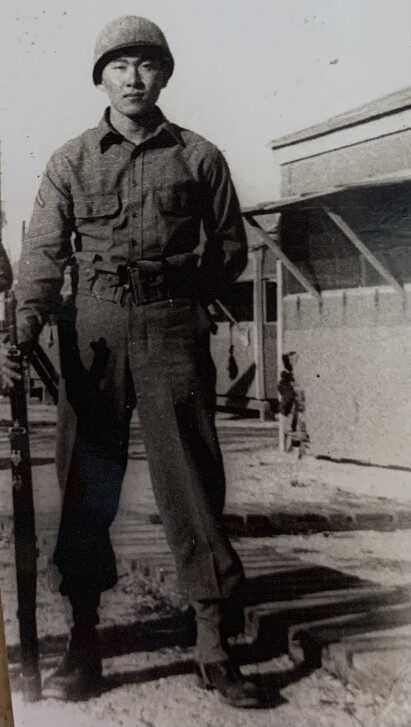
Roy Okuda was inducted into the U.S. Army on June 20, 1944, at Fort Logan, Colorado. Our research did not reveal where he underwent basic training, but photos taken at that time suggest it was a Camp Shelby, Mississippi with the 171st Infantry Battalion. The mission of this battalion was to train Americans of Japanese ancestry as replacements for the 442nd RCT.
Right: Roy during basic training, 1944
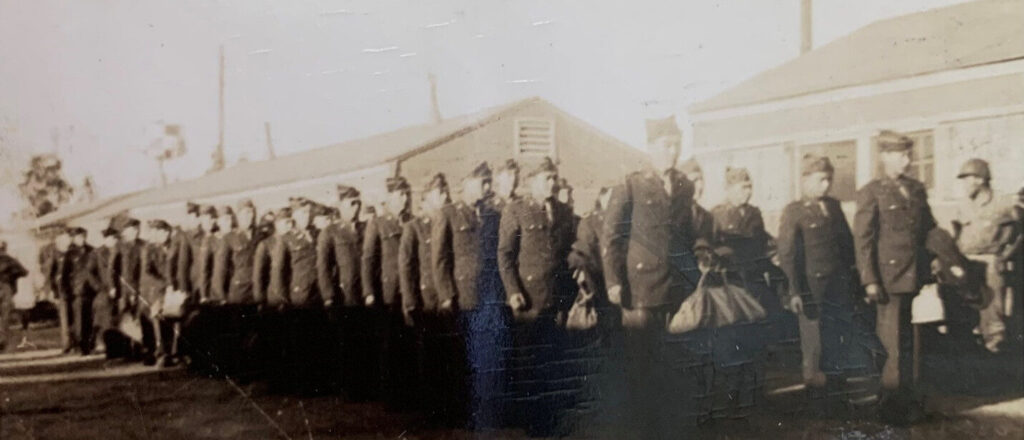
Above: Replacement soldiers for the 442nd in Meridian, Mississippi, January 11, 1945
Okuda left the US on January 23, 1945, for the European Theater, arriving on February 9. He was among the 310 replacements that arrived to the 442nd Regimental Combat Team while they were in the Rhineland-Maritime Alps Campaign in southern France. The 442nd had been there since November 1944, serving in a mostly defensive position guarding the French-Italian border against incursion by the Nazis.
Roy was assigned as a mortar crewman in 2nd Battalion, G Company. The company’s 4th Platoon was a weapons platoon with a Mortar Section and a Light Machine Gun Section. The Mortar Section consisted of three 60mm Mortar Squads of seven men each. Okuda’s exact position on the crew is not known, but as a newcomer it may have been ammo carrier rather than gunner or assistant gunner.
During their time in southern France, the men alternated between stations high in the mountains and on the sea near Nice and Menton. They were often given short passes to enjoy the nightlife in Nice – and for this reason it was named the “Champagne Campaign.”
On March 15, 1945, the 442nd was relieved from duty in the Maritime Alps and moved to a new staging area at Marseilles. On March 20-22, the Combat Team (without its 522nd Field Artillery Battalion who were sent to Germany) left France to fight in the Po Valley Campaign for the final push to defeat the Nazis in Italy.
They arrived at the Peninsular Base Section in Pisa on March 25 and were assigned to Fifth Army’s 92nd Division. It was intended that the presence of the 442nd back in Italy would be a total surprise to the enemy. For this reason, all movements were done in the utmost secrecy. The objective of the 442nd in the Po Valley Campaign was to participate in a diversionary attack on the western anchor of the German Gothic Line in Italy.
The center of this elaborate system of fortifications had been pierced in the fall of 1944, but no one had yet been able to pry the Germans loose from the western end. The Gothic Line in this area was hewn out of solid rock, reinforced with concrete, and constructed as to give all-around protection and observation. The Germans were dug into mountain peaks rising almost sheer from the coastal plain, bare of vegetation save for scanty scrub growth.
The Combat Team left their staging area and moved to a bivouac at San Martino, near the walled city of Lucca. While there, the men practiced small-unit problems with the new replacement soldiers who had yet to see combat.
The 100th and 3rd Battalions made the initial attack on the Germans beginning on April 4, while 2nd Battalion, including Pfc. Okuda, was in reserve. On April 6, after the 100th and 3rd had taken Mount Folgorito and the “Georgia” peak, 2nd Battalion was committed to action. Overnight, it gained the ridge of Folgorito and was poised for an attack on Mount Carchio and on Mount Belvedere to the north, the peak that looked down on the city of Massa.
By noon, most of 2nd Battalion was working on the wide rolling slope of Mount Belvedere, but it was slow-going as the Germans had placed their crack veteran troops of Machine Gun Battalion Kesselring to defend it. Finally, F Company broke the deadlock and cleared most of the ground at Belvedere.
On April 8, Okuda’s G Company was attacking Colle Tecchione, a mountain spur that ran west from Belvedere and ended on the eastern outskirts of Massa. They came under constant artillery and mortar fire. After a 3-hour firefight, Co. G had killed eight Germans, and taken six prisoners, three machine guns, and four mortars. They were unable to clear the ridge, however, and dug in for the night, during which they were under constant mortar and small-arms fire. They remained there the next day, as the remnants of Machine Gun Battalion Kesselring moved into the town of Pariana, only to be finished off by Companies F and H.
The 442nd crossed the Frigido River on April 10 and occupied the high ground around the marble-mining center of Carrara. By April 12, 2nd Battalion had moved farther north and was ready to attack Mount Pizzacuto, five miles north of Carrara. Okuda’s G Company was in the lead. When they hit the base of Pizzacuto on April 13, the Germans opened up with a barrage of everything they had. G Company was hit with direct fire from self-propelled guns. Once again, G Company dug in for the night. The next morning they jumped off at 8:00 a.m., meeting considerable resistance. With their mortar and artillery support, however, they carried the attack in two hours. They moved forward and were deployed to assault the German-held Fort Bastione on April 15. Following heavy artillery bombardment by the Allies, G Company seized the fort at 1:00 p.m.
By this time it was apparent that the part played by the 442nd – turning what had initially been intended as a diversion for the Fifth Army offensive into a full-scale attack along the west coast of Italy – had been a vital one. The 442nd was later awarded a Distinguished Unit Citation for the 10 days of bitter action between April 5 and April 14.
More successes for the Combat Team resulted in driving farther north, taking towns and mountain peaks along the way. The important road junction of Aulla was taken by 2nd Battalion on April 25. The prize city of Genoa was under partisan control by April 27. The next day, the 2nd Battalion, in a convoy of trucks, rolled into Alessandria in the Po Valley, where about 1,000 Germans called it quits without a struggle.
The war ended in Italy with the surrender on May 2, a week before the rest of the German forces surrendered.
At some point during the preceding months, Roy Okuda was wounded in the arm. Our research did not reveal the nature or date of his wounding.
During the occupation, Pfc. Roy Okuda served in the initial days in Novi Ligure and at Ghedi Airfield processing prisoners of war. He left Italy on July 22 and arrived back in the US on July 27, 1945.
Below: Right after the war, Roy (right) with his buddy Pfc. Omar Masayuki Kaihatsu, E Company
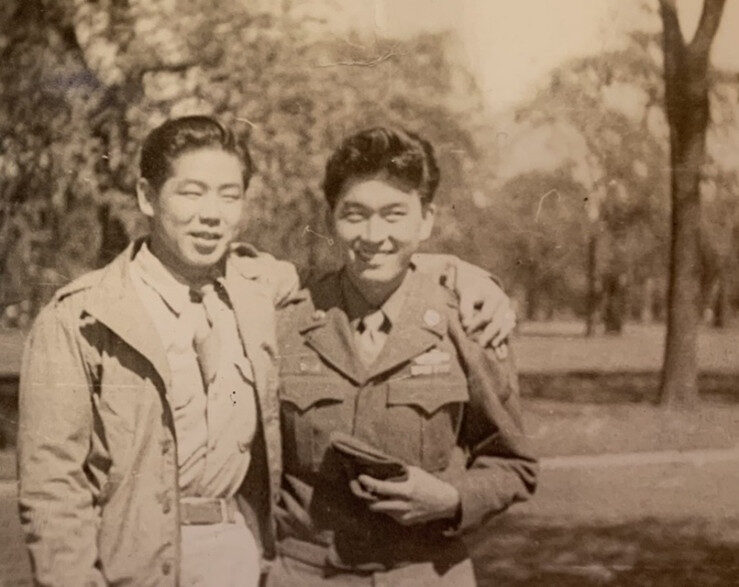
Below: Okuda pitching in a softball game at Fort Lawton
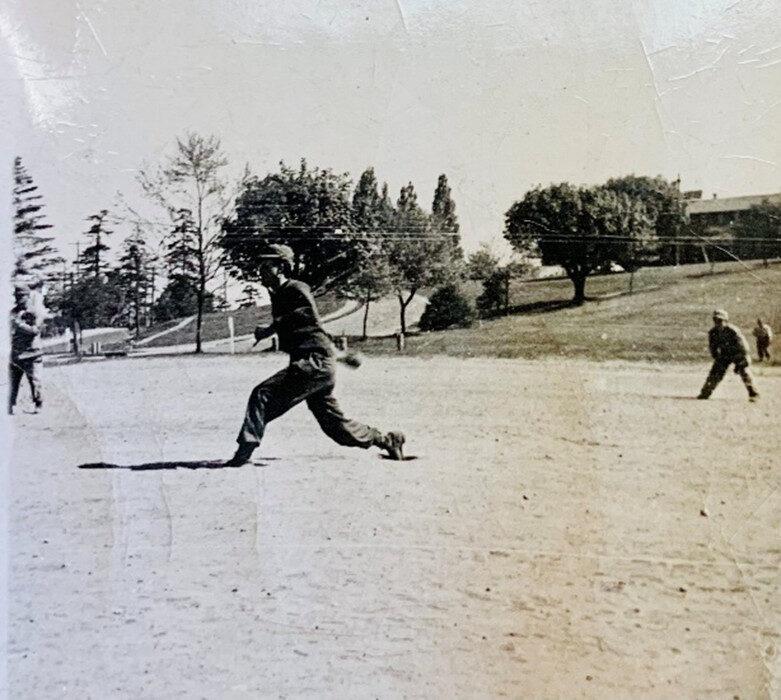
Roy continued to serve in the Army, in Company D, 9th Infantry, until his discharge at Camp Swift, Texas, on January 16, 1946. He reenlisted three days later on January 19. His reenlistment papers gave his civilian occupation as tinsmith/coppersmith/sheet metal worker. He was at Fort Lawton, Oklahoma, that May 1946.
He was then stationed for a while in Alaska’s Aleutian Islands
Below: Roy and his buddy Al (from Hawaii) in the Aleutian Islands, 1946/1947
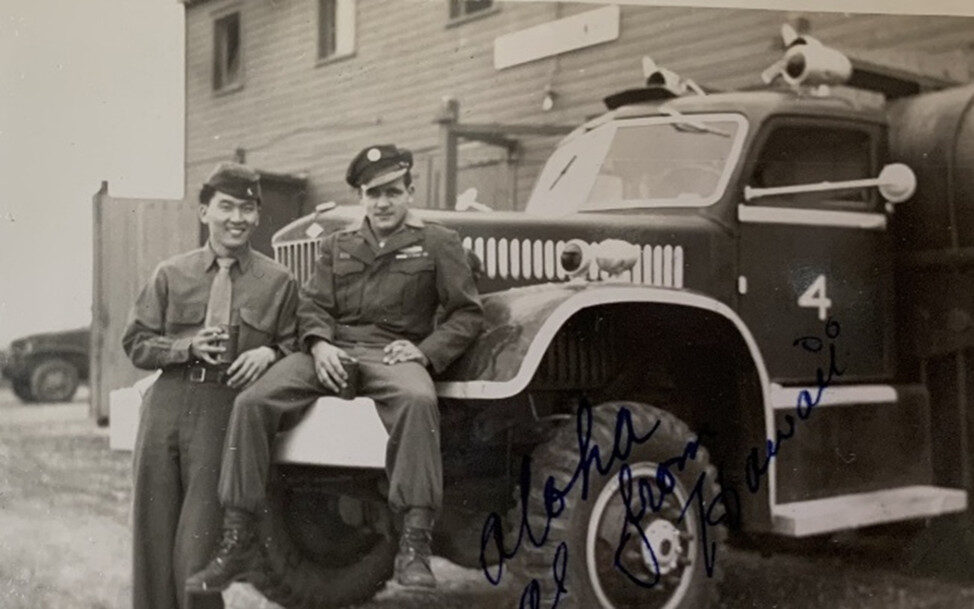
When Roy’s enlistment was up the summer of 1947, he went to Chicago, Illinois, where his family had resettled. His final discharge from the Army was there on July 18, 1947.
For his military service, Private First Class Roy Masaaki Okuda was awarded the Bronze Star Medal, Purple Heart Medal, Good Conduct Medal, European-African-Middle Eastern Campaign Medal with two bronze star devices, World War II Victory Medal, Army of Occupation Medal, Distinguished Unit Badge, and Combat Infantryman Badge. He was posthumously awarded the Congressional Gold Medal on October 5, 2010, along with the other veterans of the 442nd Regimental Combat Team. Conferred by the U.S. Congress, the award states: “The United States remains forever indebted to the bravery, valor, and dedication to country these men faced while fighting a 2-fronted battle of discrimination at home and fascism abroad. Their commitment and sacrifice demonstrates a highly uncommon and commendable sense of patriotism and honor.ˮ
In Chicago, Roy met Irene Kazuyo Doi, born April 15, 1931, to Mitsuji and Ritsue Doi of Seattle. She had been incarcerated at Amache with her family, but had not met Roy while there. Her family had settled in Chicago after the war.
Roy and Irene were married in Chicago on April 15, 1950. Roy’s 442nd friend Omar Kaihatsu was the best man at their wedding.
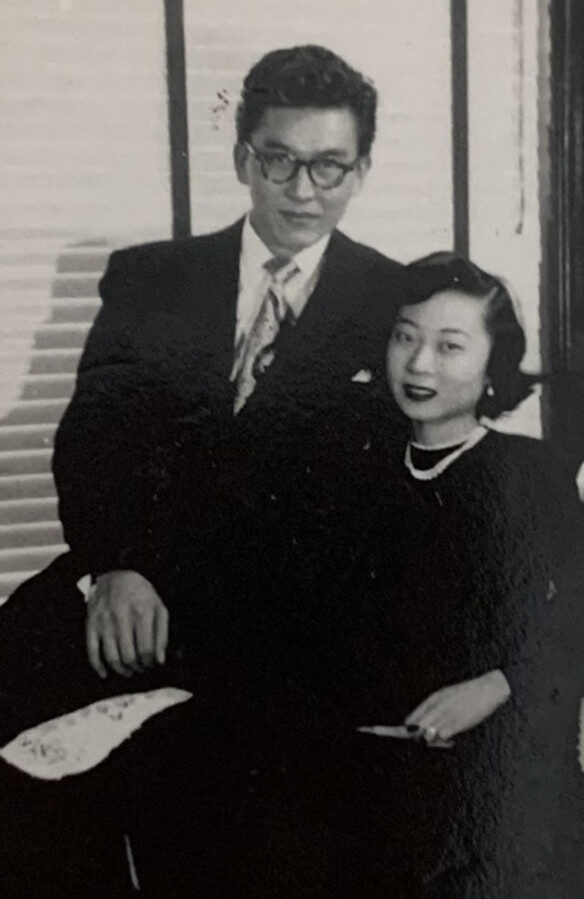
Left: Roy and Irene at the time of their wedding, 1950
Roy and Irene settled in Chicago, where their three sons and one daughter were born.
In 1960 the family moved to Los Angeles, California, and in 1961 they bought their first house, in Gardena. Roy worked as a draftsman for two different companies before he retired about 1978. He and Irene then opened a Japanese restaurant in Fountain Valley. They sold it in August 1988 and Roy was then really retired. However, Irene was employed by the City of El Segundo until she retired in 1995 when Roy’s health was declining due to a stroke.
Roy Masaaki Okuda died on October 21, 1996, in Los Angeles County, California. The family held a memorial service for him on October 27 at the Gardena Buddhist Church. He was buried at Green Hills Memorial Park, Rancho Palos Verdes, Los Angeles County, in the Sanctuary of Remembrance, Site 5-H. He was predeceased by two sons: youngest son Michael Eizan died of SIDS at the age of two months in September 1958; second son Paul Yukio died on April 12, 1999. Roy was survived by his wife, eldest son, and only daughter. His son Steven Yusho died on June 25, 2023. Irene Okuda died on January 25, 2025.
Brother Sam Sadanobu Okuda served in the Military Intelligence Service (MIS) in Japan. Brother Robert Sadamatsu Okuda served in A Company, 100th Battalion, 442nd Regimental Combat Team.
Researched and written by the Sons & Daughters of the 442nd Regimental Combat Team in 2025 with assistance by the family.